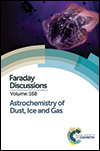Infrared and reflectron time-of-flight mass spectroscopic study on the synthesis of glycolaldehyde in methanol (CH3OH) and methanol–carbon monoxide (CH3OH–CO) ices exposed to ionization radiation†
Abstract
We present conclusive evidence on the formation of glycolaldehyde (HOCH2CHO) synthesized within astrophysically relevant ices of methanol (CH3OH) and methanol–carbon monoxide (CH3OH–CO) upon exposure to ionizing radiation at 5.5 K. The radiation induced chemical processes of the ices were monitored on line and in situ via infrared spectroscopy which was complimented by temperature programmed desorption studies post irradiation, utilizing highly sensitive reflectron time-of-flight mass spectrometry coupled with single photon fragment free photoionization (ReTOF-PI) at 10.49 eV. Specifically, glycolaldehyde was observed via the ν14 band and further enhanced with the associated frequency shifts of the carbonyl stretching mode observed in irradiated isotopologue ice mixtures. Furthermore, experiments conducted with mixed isotopic ices of methanol–carbon monoxide (13CH3OH–CO, CH318OH–CO, CD3OD–13CO and CH3OH–C18O) provide solid evidence of at least three competing reaction pathways involved in the formation of glycolaldehyde via non-equilibrium chemistry, which were identified as follows: (i) radical–radical recombination of HCO and CH2OH formed via decomposition of methanol – the “two methanol pathway”; (ii) via the reaction of one methanol unit (CH2OH from the decomposition of CH3OH) with one carbon monoxide unit (HCO from the hydrogenation of CO) – the “one methanol, one carbon monoxide pathway”; and (iii) formation via hydrogenation of carbon monoxide resulting in radicals of HCO and CH2OH – the “two carbon monoxide pathway”. In addition, temperature programmed desorption studies revealed an increase in the amount of glycolaldehyde formed, suggesting further thermal chemistry of trapped radicals within the ice matrix. Sublimation of glycolaldehyde during the warm up was also monitored via ReTOF-PI and validated via the mutual agreement of the associated isotopic frequency shifts within the infrared band positions and the identical sublimation profiles obtained from the ReTOF spectra and infrared spectroscopy of the corresponding isotopes. In addition, an isomer of glycolaldehyde (ethene-1,2-diol) was tentatively assigned. Confirmation of the identified pathways based on infrared spectroscopy was also obtained from the observed ion signals corresponding to isotopomers of glycolaldehyde. These coupled techniques provide clear, concise evidence of the formation of a complex and astrobiologically important organic, glycolaldehyde, relevant to the icy mantles observed in the interstellar medium.
- This article is part of the themed collection: Astrochemistry of Dust, Ice and Gas

 Please wait while we load your content...
Please wait while we load your content...